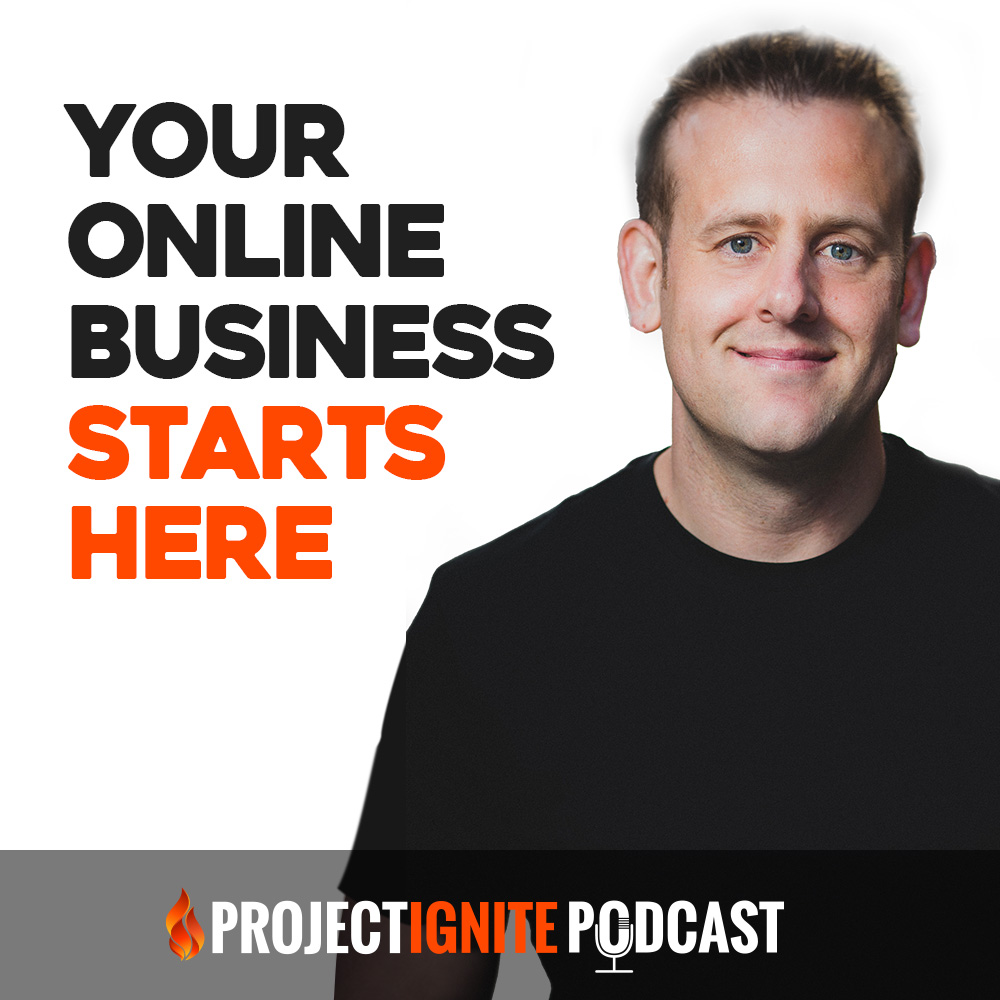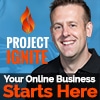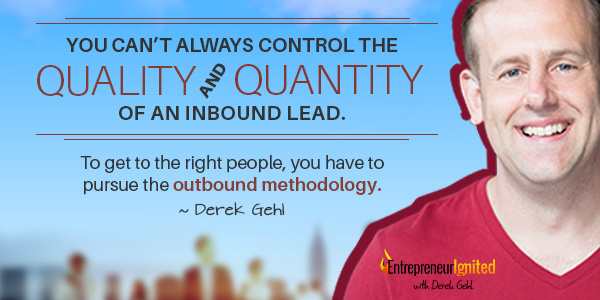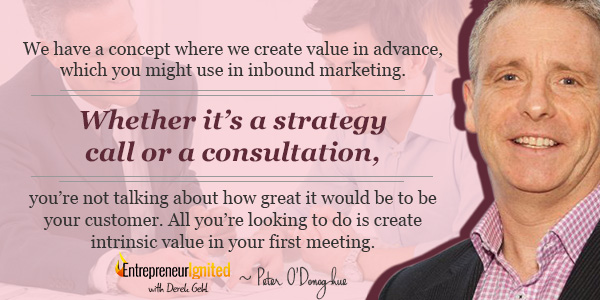Summary:
Peter O’Donoghue has been selling since he was thirteen, and you can tell. He’s not only an absolute expert in outbound sales strategies, but as you’ll find out, he knows all of the best technology available for use to make the B2B sales process as painless and as profitable as possible. This episode, we talk about Peter’s outbound model, which can lead to almost 70% response rates on cold emails. Don’t miss it!
Links:
- You can find Peter and his free outbound course at TheProspectingSystem.com
- Also check out SalesLoft.com, ToutApp.com, Marketo.com, and Datanyze.com for market and prospect research tools, hand picked by Mr. Peter O’Donoghue himself.
Transcript: How to 10x Your B2B Sales with Peter O’Donoghue
Welcome to the Project Ignite podcast–a podcast designed to skip the hype, skip the BS, and bring you real, actionable tips and strategies to help you grow your business and your income on the internet.
This is your host, Derek Gehl, and today we are going to be diving into outbound selling. I find so many digital entrepreneurs overlooking this, because we get so focused on inbound selling: bringing traffic to our websites and letting the site do the conversions.
That’s great, but the fact is, in many businesses–especially if you’re in B2B, or selling big-ticket items–outbound selling should be a part of your marketing strategy. If it isn’t, you’re probably leaving money on the table.
I know this from experience, because in my past companies, I’ve had large internal sales teams working on outbound sales, and I’ve seen the huge difference it can make.
So to jump start integrating outbound marketing into your business, I have an expert in outbound marketing with us on today’s show: Peter O’Donoghue.
Peter, thank you for being here.
My pleasure, Derek. Thank you for the interview.
Before we get started, can you share your journey as an entrepreneur? What was your path to becoming an outbound selling expert?
It’s funny, I was chatting with someone about this recently. When did I start outbound selling? The easy way is, I left school and went to university in Wales in a construction related degree. It was a quantity surveying degree.
Part of my degree was that I did a quantity surveying job, and I can remember at the graduation ceremony, as I was being handed my awards, I was thinking–I am never in my entire life going to be a quantity surveyor.
It just isn’t me. No offense to quantity surveyors, it just wasn’t for me. I had my first sales job I guess when I was about thirteen, at the Cardiff Market in a pet shop. I did Saturday jobs like that for most of my teens.
I think I was lucky, because it was partially my upbringing as well: my folks did well enough for themselves, but their motto was, I’m not giving you anything for nothing. If you go out and earn money, we’ll double your income, sure–but if you make nothing, you get nothing from us.
So I left university, and went into an assistant sales position, managing three sales people. We did cold calling, sales administration, and I progressed through the ranks quite quickly. Then the company I was with got bought out by a bigger company, which got bought out by an even bigger company, and it all just sort of culminated in selling quite high value IT services to the private and public sector.
It ranged anywhere from a couple hundred thousand to many millions in softwares and services. Then I moved into training our new companies, to commercialize their technology so we could bring it into our main offerings.
I naturally sort of progressed into training and consulting on my own. I used to do a lot of cold calling training to teach black book sales people to call and make appointments with very senior people in companies. Traditionally in the IT background.
So you’ve essentially been selling for your whole life.
I suppose, in one way or another, but I think we all do.
The reason I say that is as an entrepreneur, one of the most important skills you need to succeed in the long term is to sell.
You need to be able to sell, regardless of what you’re selling. We’re gonna dive into outbound selling and you mentioned a few words there that are really gonna freak out some of our listeners.
Things like cold calling, people have nightmares about that. Can you explain what outbound selling is, how it differs from inbound, and what kind of businesses should be using it?
Yeah, certainly. A lot of people will associate outbound selling with cold calling. But in its simplest form, you identify your ideal customer and you make outbound contact with them. That could be via telephone, or email, LinkedIn, twitter or social media. It’s the process of creating value, identifying who you can take that value to, and being proactive about approaching them.
I guess a lot of your followers are very interested with the inbound side. But as you get to higher-ticket, especially B2B, that you may find your inbound leads are just not the right quality. So either you can’t control the quantity or you can’t control the quality.
One of the reasons for that–there’s a huge study into where senior people in the top US organizations spend the most time in a buying process, it was written a few years back by IBM and a couple of other institutions. What they did was they broke the buying process down into eight segments. The most senior people in companies generally only get involved in the first three segments, and then they essentially ditch out and leave it to other people.
Those first three segments are understanding issues in the business environment; establishing long range business objectives; and setting short and long range business strategy. Once they’ve done that, they’d had it over to the middle management level, and that’s where most of that inbound happens.
They have an idea of what they need, so they go out and start looking via searches, white papers–so the idea with outbound marketing is getting to people before they set their strategy, and helping them to set their long range business strategy.
So much so, in one or two of my previous companies, if we had bids sent to us, if we didn’t write that bid, we’d refuse to bid at all. We knew that some sales person from another company had contacted that company earlier than us, managed to ingratiate themselves in one way or another, and had helped them write the specifications that make them the prime contender.
Once they’ve done that, there’s only ever one winner. And it’s not us. Once that document was written, it’s never us.
That’s the thing about outbound. It’s like the blue ocean strategy. Inbound is good for the 10%, the active searches. But that leaves 90% of the market that may not be looking at this point in time. But if you develop a relationship with them, and position yourself as an expert, somewhere down the line and they go ahead with a project, they’ll never go elsewhere.
There’s times as well when you simply cannot access the right person via inbound marketing. A recent client of mine was a senior consultant in his target market. He had around 4,000 CEOs of US manufacturing companies. They were mid-tier, so they had a turnover around $50m to $500m, that had operations somewhere outside of the US, and he had to speak to the CEO.
Those guys don’t live on LinkedIn or download white papers. So outbound is the way to unlock those relationships.
The point you drove home there is that you can’t always control the quality and quantity of an inbound lead. To get to the right people, you have to pursue the outbound methodology.
Now that you’ve covered the basics, you’ve got what you think is the best prospecting model to use. Can you give us an overview of that model?
So there’s a few different ways to look at outbound. You can do it via LinkedIn, sending direct messages. You’ve also got cold calling, and within cold calling itself, there’s a ton of opinions and polarization attempted by feeling to get a following. Art Sobczak wrote a book called Smart Calling, which is a great book, and it’s about intelligent outbound telephoning. Then you have cold emailing, which is the single biggest outbound strategy being used today. There’s a software company in the US that in a little over two years that’s gone from $0 to $4billion valuation, and that’s primarily using cold email.
So speaking to a branding friend of mine, and he said if you’re working on cold emailing, that’s what you should be known for. But there’s more than that. I’ve got cold calling experience, LinkedIn experience, and pulling in the best of both to create undoubtedly the best outbound strategy.
I use cold emailing predominantly as the bridge before the cold call, with a real slant on that. I’m not trying to sell on cold emails, but it’s a highly targeted one to one email. My system pulls all the best of those together.
Imagine you’ve got a chunk of software, and you’ve got 5,000 perfect prospects in your market. So you use your Google Chrome plugin to sift through LinkedIn and look at their profiles, which prompts them to look at yours, and then three days later they get an incredibly personal cold email which is a follow up to that.
We don’t look to sell, we just look for a response. And we get sometimes close to 60%, 70% response rate on those emails. But if they don’t answer the first one, they get a few more. We can put them into a program where if they don’t answer the fourth email, we change the emphasis of the emails to prompt them to our landing page, where we retarget them and start showing them banner ads to come book a call with us.
My system pulls in the best of all these different ways, because there is no one best way. You have to pull a system together that uses all the best ways available for doing outbound.
Okay, so, just to clarify. The system we’re talking about here, and the prospecting system, it’s not just about picking up the phone and calling someone. So we’re talking about cold emailing.
Say I have a software system that I built, and I want to sell it B2B, and I need to get to the CEO of companies to sell. How are you getting the emails in the first place?
We have never been in such an advantageous position for obtaining data. My system operates into 3 levels. The bottom segment is Mass. You have an idea about the target profile, but you’re not writing one to one yet. A lot of software and technology clients of mine use this approach.
In that instance, you profile your ideal prospect, and then you use the services available to build a list utilizing LinkedIn’s advanced search functions: position title, number of employees, region, how much they might make; what these services do is give us their first name, last name, and company name.
There’s a company called SalesLoft, SalesHack, SalesIntelligence–what they do is act as a wrapper around LinkedIn. They take the name and company name, and create permutations of what that email address could be.
First name dot last name at company name dot com, and then they’ll go and check to see if that email actually exists. If they find no emails that are live, they go away and analyze instances of email addresses from that company. If they find ten other emails from that company that are first initial dot last name, they’ll come back with the high statistical probability that the person you’re trying to reach will be at a similar address.
So it’s effectively making educated guesses at what the addresses are. I didn’t even know that these existed!
And there’s more, too.
So it goes out, and it finds the CEOs email successfully. Because you’re sending a personal email, you’re not going to build a list of 200 people and email all of them?
Well it depends on where you are, really, in the continuum. So in Mass, they’re sending out about 1,500 emails per month. And then everyone get’s a second, third, and fourth. We use a template, which is a purposely vague email. You’re looking to elicit a response. Once you get a response, you can engage.
There’s a fellow named Aaron Ross, who wrote the book Predictable Revenue. It’s brilliant, though it’s a little old now. So those emails, if you do the research properly, you know so much about that company. So you might know they’re relevant to certain clients you have.
You can put them into spreadsheets, and save that information, and then import them into your cold emailing system. Of course, then you can merge fields. Reasonably mass, but it seems like our email is one to one and is written just for that individual.
The only thing I’d say is that I wouldn’t always advocate Mass. It’s great if you’re launching a new product or company because you can penetrate the market really quickly. But I recommend that people work in the next segment, called Named Accounts. You might be talking to only 200 per month, but you’re being incredibly specific with your email templates.
That’s very purposeful: being specific to the person and the company.
Yeah. With mass, it needs to be a unique set of circumstances these days. Most people would be in Named Accounts. So you can either send it via your gmail, or you can use a major enterprise system, like Tout or Yesware. In terms of the legality, this is very different from what most people think about when they think email marketing.
Now this isn’t legal advice. But in terms of canned spam, as long as you follow certain guidelines, you fall within the compliance. You need to provide your full email, you need to have an opt-out. Though that could just be something tongue and cheek: I often get my clients to say something like, “we found your company while doing some research to see if you’d be right for our solutions. If you’d like me to stop contacting you, just reply and tell me to stop, and I’ll never darken your door again.”
Something simple but cheeky. Additionally, the headers must represent where you’re sending it from, the subject line can’t misrepresent the email, but the key thing is–and there are technology things behind it too, but–if you’re sending them out and you believe you’re gonna get spam complaints, you’re doing it wrong.
It’s not flashy HTML, it’s text based, and usually it’s one business person to another. The last thing you want to do is send a hard ball sales pitch. Three to five lines, eliciting a response. If you’re worried about canned spam, you’re doing it wrong. However, you’re well within your rights, so long as you follow the guidelines.
I have to tell you about one of these companies. So I’ve found this company called trigger events. What that means is that something has happened that has made a company more likely to engage with you. Maybe it’s a new person coming in, or leaving. If you can ring them up a few days after coming in, when they’ve got lots to prove, they’ll absolutely want to talk with you.
The program that I think you’d like is called Datanyze. It scours the internet for people using certain technology. And if it finds a change, it emails you. That sounds simplistic, but say you’re a digital marketer with a competitor. Say whenever that competitor interacts with a client, they use a searchable code that you can find.
Datanyze will find it. So say your competitor offers a 14 day trial. He takes it, and puts it into his website, or something, Datanyze will email you, and say, “here’s 100 companies that have taken up a trial from your competitor.”
Not only that, but you can click a button, it’ll go do what SalesLoft does, which we talked about earlier, and it’ll find email addresses in the same system. So if you’re in digital marketing, you can find out companies that use Marketo, SalesForce, and Tout App, say that’s your ideal. It will find those people for you.
Mark Cuban has just invested in this too, and he’s not a daft guy.
If you’re an HR consultant, or you’re selling B2B, or something like that–just take on some of this technology and your competitors will be left in the dust.
Amazing.So once you have your prospects, and the cold email, what do you do with the response?
I don’t want to blow my own trumpet, you know. But I have the grey hairs, I’ve made the cold calls, but I’ve seen the tougher side to this. Predominantly, the recommendation I see, is when they reply with anything but, please contact me, they send another email.
That frustrates me, because all people are trying to do is get the phone call, or get a prospect to book their own meeting in so they link them to a calendar. People try so hard to automate everything, but that’s not quite right.
We need a human centric conversation. You cannot automate big ticket sales. Part of my system is to think about your responses. You’re going to find things like, I’m not interested, I’m in contract, we do things in house, etc.
We have a concept where we create value in advance, which you might use in inbound marketing. Whether it’s a strategy call or a consultation, you’re not talking about how great it would be to be your customer. All you’re looking to do is create intrinsic value in your first meeting.
We go through that in my online free training. Once you’re safe in the knowledge that you have this intrinsic value, you have so much confidence. When you get people saying that they’re in contract, that’s not a hard “no”. That’s a reason to pick up the phone and speak to them. I’ve got a script that allows pretty much anyone to do this very easily.
The hardest one you can ever deal with is “I’m not interested.” So you get through, and you ask, “hello, thank you for your email just now. In your email, you said you weren’t interested at this time 400;”>, could I ask you a few questions? It may help us identify fit sometime down the road.”
That’s the opener. It’s strategically designed for a number of reasons. If someone says they’re not interested, you can take it and boil it down into “I’m not interested at this specific point in time.” They haven’t said that they’re never going to be interested.
That’s the strategic part of that opener. The worst thing you could say, following that, is “I won’t take more than two minutes” for those questions. Never offer to take something from someone, especially time.
I have three quick questions for no more than 60 seconds. That’s how we address that. Then we follow up: it will help us identify if there may be a fit sometime in the future. You’ve now alleviated any sales pressure.
Most people see the sense and the logic in that. You get a really high open rate. You use that open every single time. The front end email does most of the work, and then you give them the script.
The first question is a no brainer that they have to answer yes to.
Do you have outbound sales people prospecting? Yes, I do.
Then you move to your next question. Second one is a little bit tougher, and the third question is open ended and suggests a little bit of commitment. That’s meant to lead to a conversation. Once that conversation has naturally wound to a point, you should try to schedule a meeting.
This is where people fail, because they try to pitch it. I want to tell you how much money I can save you. That’s not it, though.
You get to the end part of the script, and you say, “John, based on everything you’ve told me, it seems like you’d be a great fit for a discovery call with my account executive, Steve. On that call, he’ll give you an insight into your competitors strategies, and leave you with a benchmarking study that we’ve created that shows you the peak performance strategies that companies are using in your industry.”
So naturally, that needs to be more specific. But you run them through that, and 70% of the time, people agree to that phone call.
That was brilliant. I was taking notes there as you were talking. So much of that can be applied to multiple face to face type selling. So for those of you that are listening, go back, and listen again. That was gold.
So we’re almost out of time, unfortunately, because I’ve still got a ton of questions for you. That was absolutely fascinating.
I’m a digital entrepreneur, and I’ve had outbound sales teams, but never on that level. Since I sold my last business, about four years ago, I haven’t had a team to do that. Over the last four or five years, what I’m hearing and seeing, the technology that exists for prospecting is phenomenal.
It’s hard to answer concisely really. LinkedIn we use to build our lists, but we don’t make contact on LinkedIn itself.
There’s a service called RingLeadCapture, so if you’ve got a webpage of all companies within a chamber of commerce or within a franchise, you can select the whole webpage, and it will go away and research them all. It’ll find direct phone numbers, social profiles, everything.
List brokers are kind of going extinct now. With this new software, we see sometimes an 8% bounce rate when our lists are being compiled like that in real time.
There’s a service called You Know Me, it’s a top end kind of thing, that allows you to find highly statistically relevant of people in an organization. So it’s not about getting thousands of emails per month, but it can find and organize employees by their positions. It’s always being updated based on their company profile on LinkedIn.
Fantastic. Alright everyone, that was outbound selling expert Peter O’Donoghue. As usual, all of the links will be included in our show notes along with the transcript of this episode. You can find that over at ProjectIgnite.com/podcast.
Of course, if you haven’t done so already, you can subscribe to this podcast to make sure that you never miss an episode. Find me on iTunes by searching Project Ignite, Derek Gehl, or Internet Marketing. You can do that on Androids as well, just do it on Soundcloud.
Also, please leave a review, tell us what you think. That’s what gives me the motivation to keep creating this information packed podcast for digital entrepreneurs. If you want some more tips and tools, check out our weekly profit report newsletter over at ProjectIgnite.com.
Now it’s time to take the tips, tools, and strategies that we’ve learned here today, and apply the final essential ingredient to make this all work for you: that ingredient is action. Go forth, take action, and stay tuned for more info-packed episodes of the Project Ignite podcast–a podcast designed to simplify online business so you can make more money.
This is Derek Gehl, signing off.

















Thanks Derek. I especially like the banner image where your designer has attempted to make me look younger by replacing my grey hair with black. My girlfriend is still laughing now!!:-)
Thanks for your professionalism and enthusiasm with the interview.